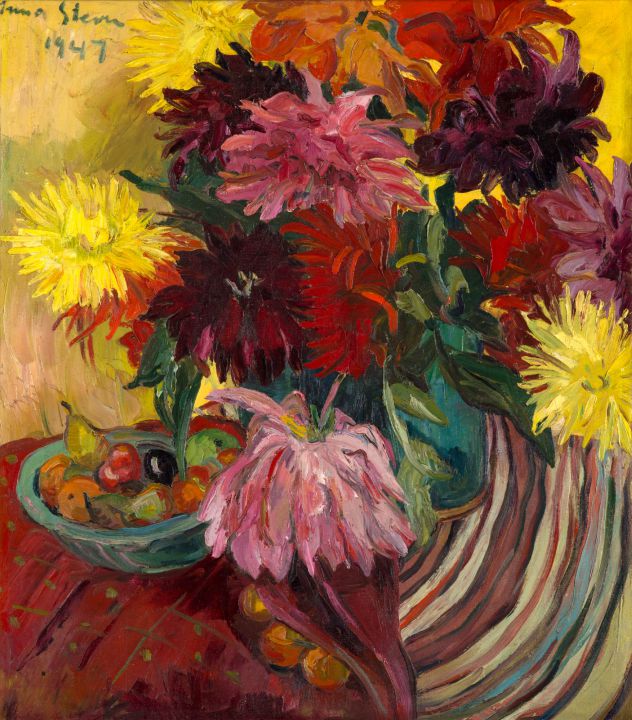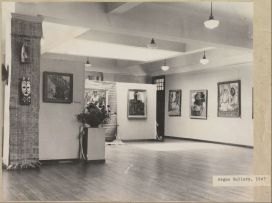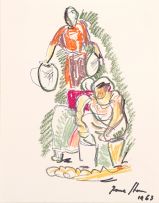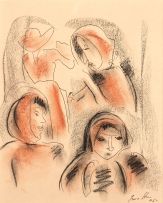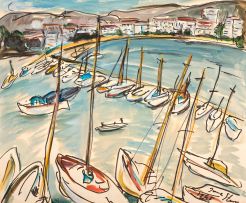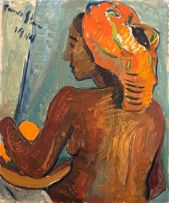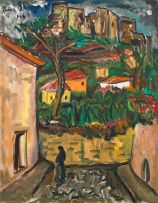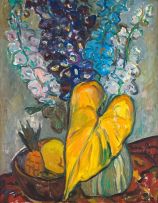Dahlias
Irma Stern
Incl. Buyer's Premium & VAT
About this Item
signed and dated 1947; inscribed with the artist's name, address and the title on the stretcher
Notes
Still life paintings featuring flowers and fruit feature prolifically in Irma Stern's oeuvre. Grouped with the objects she collected - in particular, her oriental ceramics and African artefacts and textiles, and sometimes presented in Zanzibari frames - the celebration of floral and vegetal forms gave free rein to her abundant creative passion for exoticism, sensuality and, above all, colour. Although she would return to this subject throughout her career, some of the most powerful examples of this genre were produced during the 1930s and throughout the 1940s.
While every one of Stern's many flower paintings is unique, they generally share some common characteristics. In addition to the inclusion of objects from her collection (which serve at once as vessels to contain the organic elements as compositional elements of visual interest in their own right), they are set in a fairly shallow pictorial space with a forced perspective that tilts the horizontal plane towards the viewer and are often set against the backdrop of Stern's canary-yellow studio. This backdrop - so omnipresent as to almost be a subject in itself - in turn allowed a dramatic and dynamic play of complementarity, particularly when set behind the brightly coloured flowers that Stern preferred.
While Stern's taste in flowers was catholic - any and all flowers, from common varieties that grew in her garden,1 to blooms from the giant Magnolia grandiflora that still graces 'The Firs', her former home and now the Irma Stern Museum, to lush hothouse varieties that she would have acquired from local flower sellers - were painted with the same sense of reckless delight. Nonetheless, she would return to some varieties again and again, particularly those, like chrysanthemums, lilies, anthuriums and dahlias, that lent themselves to her expressive impasto technique. Of particular interest with regard to this painting is that dahlias were a recurrent theme during the 1930s and 40s, with five still lifes - of which this painting is the fifth - featuring these sumptuous cut flowers dating from this period.
Stern would return to the theme a decade later, in 1958, in the uncharacteristically muted Still Life with Dahlias in a Vase with Fruit in a Dish, and again in one of her late important paintings, A Still Life of Dahlias and Fruit, in 1960 (fig. 1).2
Although the 1960 painting is notable for its "almost delirious explosion of brilliant, hot colour"3 and a particular kind of expressive freedom that suggests that she "was closer in spirit to her international, post-war contemporaries than she has been given credit for",4 it is in many ways a restatement of this 1947 painting. This is not surprising: of the seven, the 1947 Dahlias is arguably the most compelling in its balancing of colour, the most dynamic in its disruption of pictorial space, and the most compositionally unusual. One can thus understand the mature Stern's desire to return to its vigour and visual drama.
In order to better understand the particular strengths of the 1947 Dahlias, it is worth considering it in relation to its predecessors. The first (fig. 2), painted in 1930, is perhaps the most conventional. Reminiscent of 18th-century Dutch flower paintings both in mood and style (unusually in Stern's flower paintings the wilting blooms shedding their petals hearken back to the lugubrious symbolism of vanitas), there is little in this painting, apart from some vigorous brushwork and brownish-green glazed Chinese jar5 in which the flowers are placed, to suggest the expressive dynamism and exoticism that would famously come to characterise Stern's mature work.
The second (fig. 3), painted in 1937, pushes a relatively modest bouquet of pink and red dahlias to the back of the composition, which is dominated by the watermelon, shown sliced in half on the left with a single wedge presented on a copper bowl with brass feet and handles to the right. While more assertively expressive in its style and effect, the composition is conventionally triangular in a shallow pictorial space with a somewhat foreshortened perspective.
The third (fig. 4), painted in 1940, is bolder both in its use of saturated yellows and reds painted in thick impasto, and compositionally, with the horizontal plane shifted downwards. The bright red and yellow shades of the dahlias are offset by the viridian green of the vessel in which they are placed, a partially glazed, oviform Chinese jar6 with three vertical ears attached to its neck that features in a number of Stern's still life paintings from this period. The dominant orange and red tones of the painting are intensified by the canary yellow background and bright yellow-green of the lemon in the foreground.
The fourth painting (fig. 5), from 1946, presents something of a departure from the preceding three. It follows Stern's second visit to Zanzibar in 1945 (the first having been in 1939), and both compositionally and tonally it is perhaps closer to her portraits of Zanzibari people painted in the early 1940s than to the by-then established format of her still life paintings. Like the portraits, the pictorial elements - comprising dahlias in a partially glazed Chinese martaban jar,7 two bowls of fruit on Zanzibari woven mats,8 and two large papayas - are presented in a flattened pictorial space, crowding the surface of the canvas.
Within the overall tonalities of orange, red and yellow, the largely obscured bright yellow background has the effect of increasing the shallowness of the space rather than providing a sense of depth. A strong tonal contrast is provided by the dark purple-black of two bunches of grapes, a tone that is picked up in the blackish-brown streaked glaze of the jar, showing hints of celadon underneath. Bluish-green hints are repeated in the stripes of the woven Zanzibari mat, which in turn is tilted forward so dramatically as to be almost parallel with the picture plane. Further reinforcing the formal link to many of
the Zanzibari portraits, this still life is presented in a carved Zanzibari
frame.
A powerful statement of Stern's interest in the exotic and sensual, it is unsurprising that this painting set a record for the highest price paid to that point for a 20th-century South African artwork when it sold for one million rand at an auction in 1999.9
Painted in the following year, the 1947 Dahlias (fig. 6) is a compelling synthesis of the formal concerns of all four the preceding paintings dealing with the same subject. Like its predecessor from 1946, the composition features a Zanzibari mat whose woven stripes add a dynamic visual rhythm to the composition. Whereas the mat in the 1946 painting is presented in such a way that it can be immediately perceived for what it is (its shift in perspective notwithstanding), in this painting it is reduced to its abstract essence by means of a series of parallel lines curving dramatically up the bottom right-hand side of the composition, effectively rendering the horizontal plane vertical. As a dynamic visual element, this forced perspective pushes the flowers vertiginously forward into the viewer's space, a dramatic effect that is reinforced by the thick impasto delineating the flowers' petals.
Although essentially the same colours as the flowers, the muted tones of the stripes have the effect of further intensifying the colour of the flowers, which demand the viewer's attention with a particular urgency. The vessel containing them - a Ching dynasty glazed martaban jar10 - is of secondary importance, but immediately identifiable by its characteristic viridian green, which is echoed in the celadon bowl11 containing the fruit. Unlike in the preceding paintings, the fruits here are relegated to a supporting role, their smaller scale and consistent tones of orange and green deflecting attention to the flowers. Three small orange fruits have escaped the bowl and are partially covered by a fold in the bright red tablecloth. Compositionally, they balance the stripes of the Zanzibari mat, but more importantly have the effect continuing the curve of these stripes, leading the eye upward to the foremost bright pink dahlia, which seems to burst out of the picture plane. A purple-black dahlia in the top right-hand corner of the composition contrasts dramatically with the lemon-yellow background and is balanced tonally by a single black plum glistening in the fruit bowl. This dark circular form is something of an antithetical focal point, serving both to draw the eye back into the pictorial space, and as a pivot around which the visually dazzling drama of the stripes and the impasto petals swirl.
Stern's biographers12 agree that the mid-1940s marks the highest point of her career, a moment at which she was at the height of her powers both technically and professionally. In its mastery of technique, style and content, this painting provides ample evidence of this. It was exhibited at the Argus Gallery in Cape Town in 1947 along with a number of significant Zanzibar- and Congo-inspired paintings, including Watussi Woman in Red (1944) and Banana Carrier, Lake Kivu (1946) (fig. 7). In the same year Stern also exhibited at the Gainsborough Gallery in Johannesburg and the Wildenstein Gallery in Paris, and the first of two films on her work was released by the South African Department of Information.
It is likely that it was also at this time that the paintings was acquired by its first owners, the Cape Town-based collectors Ben and Cecilia Jaffe. The Jaffes' Rosebank home, 'The Boltons', was a centre of bohemian cultural life in the 1940s and 50s. As the composer Stefans Grové recalled,
On Sunday evenings the Jaffes' home would be open to anyone with an interest in the arts. Amongst the regular visitors were Lippy Lipshitz, Irma Stern and others. With a glass of whisky in one hand and a pipe in the other, Oom [uncle] Ben would always stand, like a chairman by these improvised debates on all subjects under the sun. Only politics and religion were taboo.13.5Despite his relatively modest income as a bookkeeper, over the course of their lifetimes the Jaffes acquired a remarkable collection of artworks by South African artists who were their contemporaries. After their deaths a portion of the collection was auctioned by Sotheby's, in October 1981. Dahlias was not amongst the works in that auction, having been bequeathed to the Jaffes' daughter Phyllis Levenstein. Levenstein later put the painting up for sale, at a Stephan Welz & Co in association with Sotheby's auction on 24 March 1994, where it was acquired by Count Natale (Luccio) Labia.
Count Labia, who died in November 2016, was a scion of the prominent Cape Town family. His father, the Italian diplomat Natale Labia, had been the first royal minister plenipotentiary appointed by the Italian crown to South Africa, and was posthumously awarded the hereditary title of Prince in 1936. Prince Labia's wife, Princess Ida Louise (née Robinson) had inherited a substantial art collection from her father, the Randlord Sir Joseph Benjamin Robinson. Upon her death in 1961 the collection was in turn inherited by their two sons who divided it equally amongst themselves. Over the course of his lifetime, Luccio Labia acquired a collection of his own to augment the Robinson Legacy, a selection of which, including the Dahlias, is now being sold by his heirs.
Dahlias has an impeccable provenance. It began its life keeping company with some of Stern's most admired paintings, and has spent most of its seventy-one years gracing two of Cape Town's most respected collections. Combined with its technical virtuosity, it is therefore difficult to overstate the importance of this painting. Formally, it is probably the finest example of the kind of technical breakthrough that Stern described in 1945, characterising her works of the period as, "abstract of curious values … [that] … one day soon … will bring me the same freedom in form and composition - as I have gained in colour".14 In the final analysis, however, it the painting's glorious and irrepressible sense of dynamism and joie de vivre that makes it an extraordinarily compelling work in, even in an oeuvre as prolific and rich as Stern's. - Prof. Federico Freschi
1. In a letter to her friend Trude Bosse, dated 14 November 1928, Stern described the scene in her garden: "[L]arkspur, stocks, enormous geraniums, all shades of pelargoniums, great balls of white and also yellow daisies, violet and yellow poppies, sunflowers, and many, many roses, carnations, petunias, fuchsias" (in Karel Schoeman (1994). Irma Stern: The Early Years, South African Library, Cape Town. Page 88). Ninety years later, the scene is somewhat different. As Christopher Peter, long-time Irma Stern Museum curator, notes, "The garden at 'The Firs' … is cold, shady and tricky. … Not nearly enough sun or the right soil for zinnias, larkspurs and delphiniums which often feature in her still lifes" (Christopher Peter, 'The Creation of Irma's Still Lifes - A Personal View' in Wilhelm van Rensburg (ed.), Life Force: The Still Lifes of Irma Stern, RMB Turbine Art Fair, Johannesburg, 2018, unnumbered page)
2. A Still Life of Dahlias and Fruit (1960) was auctioned by Strauss & Co on 25 March 2010.
3. Strauss & Co. Irma Stern - Still Life with Dahlias and Fruit, 25 March 2010. Accessed 18 August 2018. https://www.straussart.co.za/press/release/2010-03-25-irma-stern-still-life-with-dahlias-and-fruit.
4. Ibid.
5. A 19th or 20th century copy of a Yuan jar in the Irma Stern Trust Collection, accession number 528.
6. Irma Stern Trust Collection accession number 530.
7. A martaban jar of Southern Chinese origin, possibly Yuan or later. Irma Stern Trust Collection accession number 533.
8. Both this martaban jar and the Zanzibari mat are featured in Still Life with Magnolias, Apples and Bowls, indistinctly dated 1944/49. Photographs of similar mats are illustrated in Irma Stern's Zanzibar. JL van Schaik: Pretoria, 1948; pp. 42, 63-64, and 80.
9. Chimaimba Banda, Irma Stern painting sells for record R1m, 8 November 1999. Accessed 18 August 2018.
https://www.iol.co.za/news/south-africa/irma-stern-painting-sells-for-record-r1m-18924.E
10. Marion Arnold mistakenly identifies this as a "woven Congolese mat" (Irma Stern: A Feast for the Eye, Fernwood Press: Vlaeberg, 1995, p. 126. However, as noted in footnote 8 above, the mat is of Zanzibari origin.
11. A Sung dynasty monochrome celadon bowl, Irma Stern Trust Collection accession number 512.
12. See Esmé Berman, Neville Dubow, Marion Arnold, Irene Below, et al.
13. Stefans Grové, 'Uit herinnering se wei', in A Composer in Africa: Essays on the Life and Work of Stefans Grové, by Stephanus Muller and Chris Walton, Stellenbosch: SUN Press, 2006, pages 77-78. My translation.
14. Quoted by Sandra Klopper in 'Life Force: The Still Lifes of Irma Stern" in Wilhelm van Rensburg (op. cit.).
Provenance
The Ben and Cecilia Jaffe Collection.
By decent to Mrs Phyllis Levenstein.
Stephan Welz & Co in association with Sotheby's, Cape Town, 24 March 1994, lot 343.
The Labia Collection.
Exhibited
Argus Gallery, Cape Town, 1947.
Irma Stern Museum, Cape Town, Irma Stern as a Flower Painter, February 1982.
Literature
Marion Arnold (1995). Irma Stern: A Feast for the Eye, Cape Town: Fernwood Press for the Rembrandt van Rijn Art Foundation. Page 126, illustrated in colour on page 124 with the title Still Life with Dahlias.
Stephan Welz (1996). Art at Auction in South Africa: The Art Market Review 1969 to 1995, Cape Town: Creda Press. Illustrated in colour on page 104.
